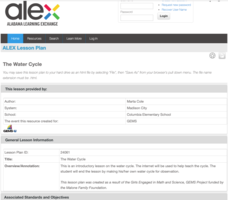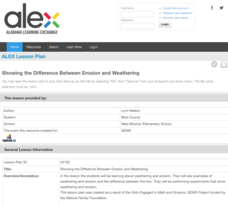Alabama Learning Exchange
What Color Are The Leaves?
Young scholars identify the colors in leaves. In this chromatography lesson, learners read the book Why Do Leaves Change Color? and construct chromatography strips to identify the colors of leaves.
Alabama Learning Exchange
As Large As Life. . . A Poster of a Human Body System
Learners explore the major systems and functions of the human body. In this anatomy lesson, young scholars make life-size outlines of bodies, diagram body systems, and present their work to their classmates.
Alabama Learning Exchange
Air is All Around You
Pupils investigate the mysteries of air. In this science lesson, students participate in hands-on activities that require them to use the scientific inquiry model to study air.
Alabama Learning Exchange
Lining up the Decimals
Fifth graders order decimals from least to greatest and greatest to least. In this decimal order instructional activity, 5th graders complete an online review of comparing 2 digit numbers. Students then complete a decimal order card game...
Alabama Learning Exchange
Waste Not, Want Not
Pupils determine what materials are able to be recycled. In this environment protection lesson, students read The Three R's: Reuse, Reduce, Recycle and discuss landfills. They are given an item to decide if it can be recycled. They play...
Alabama Learning Exchange
The Path to Positive
Students demonstrate how to add positive integers. In this computation instructional activity, students read the book Less Than Zero and use a number line and counters to play an addition game using positive integers.
Alabama Learning Exchange
Seeds: How They Grow
Students observe the growing stages of plants. In this plant growth lesson, students collect, germinate, and plant seeds to chart the growth process of plants.
Alabama Learning Exchange
What's Your Favorite Chocolate Bar?
Young scholars complete a math survey. In this math graphs lesson, students complete a survey about their favorite candy bars. Young scholars create different kinds of graphs using Microsoft Excel to show their results.
Alabama Learning Exchange
Coral Reefs
Study explore coral reefs. In this coral reef instructional activity, 4th graders examine the physical structure of coral reefs. Students consider why coral reefs need to be protected and ways to protect them.
Alabama Learning Exchange
Botany Scavenger Hunt Where's the Ginkgo?
Learners use a science journal to log plants that are native to Alabama. In this plant lesson plan, students identify characteristics, describe environments, and classify the plants that they find.
Alabama Learning Exchange
Men and Women of Space Exploration
Fourth graders research famous astronauts. For this space science instructional activity, 4th graders list famous astronauts and use reference materials and the Internet to write a report on them.
Alabama Learning Exchange
What Is An Inch?
Students identify the length of an inch. For this measurement lesson, students read Inch by Inch and predict how many inches long various objects are. Students practice measuring the objects by using an inch ruler.
Alabama Learning Exchange
Musical Patterns
Young scholars explore the concept of patterning using musical instruments. In this music lesson plan, learners identify several instruments and practice playing patterns with them. Young scholars identify the patterning in a musical piece.
Alabama Learning Exchange
The Causes of Pollution
Learners identify types of pollution. In this environmental lesson, students view a video and discuss the types of pollution. Learners create a poster to suggest ways to prevent pollution.
Alabama Learning Exchange
Number Clues
Students practice problem solving. In this number identification lesson plan, students practice identifying numbers based on clues or characteristics given. They also work in groups to identify the clues for given numbers.
Alabama Learning Exchange
I Scream for Ice Cream!
Learners perform an experiment. In this combinations lesson, students complete an experiment where they find out how many ice cream cone combinations they can make with 5 different flavors of ice cream and 4 types of cones. They design a...
Alabama Learning Exchange
Tornadoes
Students research tornadoes. For this weather lesson, students construct a KWL chart on tornadoes and view the video National Geographic-Tornadoes. Students discuss the facts they learned from the film and complete the KWL chart.
Alabama Learning Exchange
I Will Survive
Young scholars explore animal adaptations. In this animal science lesson, students watch the video "Kratt's Kreatures" and work in groups to complete a worksheet about animal adaptations.
Alabama Learning Exchange
The Water Cycle
Students explore the water cycle. In this earth science lesson plan, they read the book Water Dance by Thomas Locker and use an interactive whiteboard to review the water cycle with an interactive website.
Alabama Learning Exchange
Showing the Difference between Erosion and Weathering
Learners explore the concepts of weathering and erosion. After viewing pictures of both erosion and weathering, students work in pairs to conduct an experiment with sugar cubes, water, sand, and a straw. They write their predictions and...
Alabama Learning Exchange
This Is How We Roll!
Students research how roller coasters work. In this physics lesson, learners research the history of roller coasters and the safety factors in the design of a roller coaster on the website www.learner.org/exhibits/parkphysics. They...
Alabama Learning Exchange
Investigating Friction
Young learners explore friction. They view a video or DVD (bibliography provided) and define terms related to friction, and work in groups to experiment with the effects of friction on speed and motion using ramps and toy cars.
Alabama Learning Exchange
Pizza! Pizza! Pizza!
Fifth graders practice using money in everyday situations. They use their addition and subtraction skills as they work in cooperative groups to solve problems involving decimals.
Alabama Learning Exchange
Scaling Down the Solar System
Learners work collaboratively to gain a better understanding of the vastness of space by scaling down the solar system. They measure by inches, gain an understanding of space, and model the distances of the planets from the sun.








